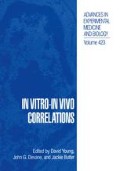Abstract
USP1 describes the in-vivo/in-vitro correlation as the “establishment of a rational relationship between a biological property, or a parameter derived from a biological property produced by a dosage form and a physicochemical property or characteristic of the same dosage form”. In relation to a formulation, the most commonly used biological properties are the pharmacokinetic parameters such as Cmax or AUC, obtained following the administration of the dosage form while the physicochemical property is the dosage form’s in-vitro dissolution performance such as percent of drug released under a given set of conditions. The relationship between these two biological and physicochemical properties, is then expressed quantitatively. For rapidly dissolving (less than 15 minutes) immediate release formulations, an in-vitro characterization could be made using a single dissolution point. This however cannot be said for immediate release formulations consisting either low solubility actives or slowly dissolving matrix or for modified release formulations. In these cases, a dissolution profile and not a single dissolution specification point, is more appropriate. If an adequate in-vitro/in-vivo relationship is established using a suitable technique such as statistical moments or deconvolution, an insight into the pharmacokinetics could be obtained from the formulation’s in-vitro dissolution performance. More importantly, in case of an alteration in the dissolution profile characteristics, it allows one to raise a flag about the possible alteration in the in-vivo performance and pharmacokinetics.
Access this chapter
Tax calculation will be finalised at checkout
Purchases are for personal use only
Preview
Unable to display preview. Download preview PDF.
References
U.S. Pharmacopeia 23 and National Formulary 18, 1995.
M.C. Meyer et al. The bioequivalence of carbamazepine tablets with a history of clinical failures. Pharmaceutical Research 9(12): 1612–1616 (1992).
Guidance for Industry. Immediate release solid oral dosage forms; Scale-up and post-approval changes. FDA/CDER, November 1995.
Guidance for Industry. Extended release solid oral dosage forms; Scale-up and post-approval changes. FDA/CDER, July 1996
J.W. Moore and H.H. Flanner. Mathematical Comparison of Dissolution Profiles Pharmaceutical Technology 20(6): 64–74 (1996).
A. Resigno. Bioequvalence Pharmaceutical Research 9/7: 925–928 (1992).
Y. Tsong, T. Hammerstrom, P. Sathe and V.P. Shah. Statistical assessment of mean differences between two dissolution data sets. Drug Information Journal 30(4): 1105–1112 (1996).
Fred M. Hoppe. ed., Multiple Comparisons, Selection and Applications in Biometry, Marcel Dekker Inc., New-York, 1993.
Y. Tsong, P. Sathe and V.P. Shah, American Statistical Association Proceedings of the Biopharmaceutical Section (in print) 1996.
H. Akaike. IEEE Trans.Automat.Contr. 19: 716–723 (1974).
F. Langenbucher. Linearization of dissolution rate curves by Weibull distribution. J.Pharm.Pharmac, 24: 979–981 (1972).
P.M. Sathe, Y. Tsong and V.P. Shah. in-vitro dissolution profile comparison: statistics and analysis; model dependent approach. Pharmaceutical Research, 13(12): 1798–1802 (1996).
R.A. Johnson and D.W. Wichern, Applied Multivariate Analysis, Prentice-Hall Inc, New Jersey, 1989.
A. Kayali. Bioequivalency evaluation by comparison of in vitro dissolution and in vivo absorption using reference equations. Eur. J. Drug Met. and Pharmacok. 3: 271–277 (1994).
Author information
Authors and Affiliations
Editor information
Editors and Affiliations
Rights and permissions
Copyright information
© 1997 Plenum Press, New York
About this chapter
Cite this chapter
Sathe, P., Tsong, Y., Shah, V.P. (1997). in Vitro Dissolution Profile Comparison and IVIVR. In: Young, D., Devane, J.G., Butler, J. (eds) In Vitro-in Vivo Correlations. Advances in Experimental Medicine and Biology, vol 423. Springer, Boston, MA. https://doi.org/10.1007/978-1-4684-6036-0_3
Download citation
DOI: https://doi.org/10.1007/978-1-4684-6036-0_3
Publisher Name: Springer, Boston, MA
Print ISBN: 978-1-4684-6038-4
Online ISBN: 978-1-4684-6036-0
eBook Packages: Springer Book Archive

